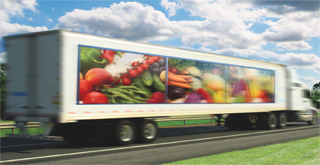Sometimes reinventing the wheel is a good thing, especially when it comes to fresh produce packaging. Imagine this packaging problem faced by a major retailer: box-shipped asparagus did not allow the product to be displayed vertically on the shelf. This meant asparagus bunches had to be placed horizontally, presenting customers with the less-than-glamorous bottom ends of the spears.
Efforts to correct the dilemma led to a new yet simple box design. Although package performance at the retail level was the catalyst behind this particular redesign, the packaging team at California Polytechnic State University had to be cognizant of the impact on shipping costs as well.
Jay Singh, professor and packaging program director in the Orfalea College of Business at Cal Poly in San Luis Obispo, led the research team that helped Gourmet Trading Company of Los Angeles, CA develop an innovative two-piece box. The new box allowed product to be displayed upright, maintaining contact with the moisture pad, and required minimal handling by retailers during stocking. In-lab simulations also showed the design would maintain product integrity during long-distance transport from South America.
“The goal was to reinvent their current package from a design and distribution perspective,” Singh explains. Although the new design was two-pieced, it used the same amount of material as its predecessor—avoiding any increases in shipping weight—and was still able to prevent any product damage during transport.
Although the evolution of fresh fruit and vegetable packaging has often been driven by retailers, the outcome can be mutually beneficial to shippers, transporters, retailers, and even consumers as well.
Weighty Issues
Package weight, as shippers know, can play a major role in transportation costs—from filling trailers to capacity and maintaining legal cargo limits to the number of trips and fuel consumption. Finding ways to reduce package weight is never simple, but even modest changes make a big difference.
Michael McCartney, founder and principal of QLM Consulting, Inc., based in Sausalito, CA says, “Packaging is a game of very small numbers” with many parameters, but when done right, he says, it can add up to big savings.
Reducing the weight of a carton (or clamshell), even minimally, allows more packages on a truck, which can translate into better efficiency and even less trucks on the road or fewer trips to destination. Altering how a product is packaged, for more accurate weight, can also influence overall shipping cost.
“For example, a very large grape producer packs a 3-pound clamshell for a major retailer,” McCartney explains. “The weight, including [allowances for] shrink, would be 3.26 pounds. On average, the weight of each clamshell is 3.72 pounds, so with 6 clamshells to a box, this company is giving away almost 1.5 pounds of product to the retailer.”
Less packaging is meant to appeal to consumer interest for more eco-friendly materials, but also to reduce carbon footprints. The latter has ramifications for transporters, as packaging weight and size
can affect fuel consumption at a time when diesel rates have topped more than $4 per gallon in most markets.



